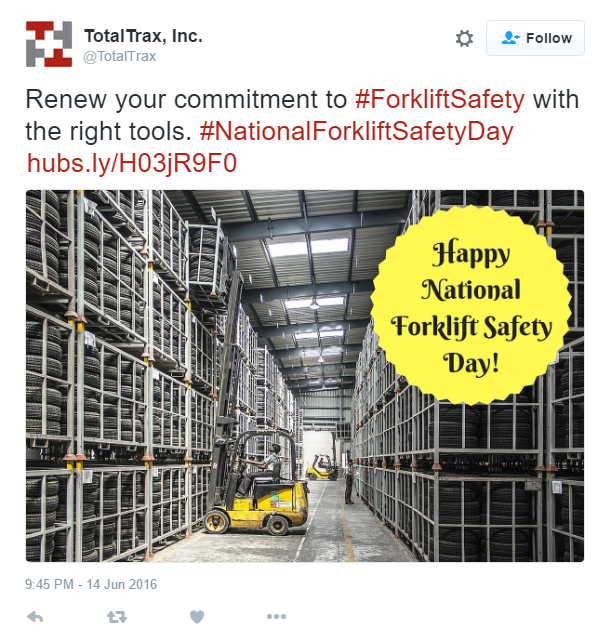
by Fronetics | Jul 29, 2016 | Blog, Content Marketing, Marketing, Strategy, Supply Chain
Here I share some of our best performing content from the first half of this year.
Auditing your content and adjusting your strategy is an important part of an effective content marketing program. I like to do an in-depth look at how our content is performing every six months.
As I was evaluating our most popular articles in the first half of 2016, one of the things that struck me was how well they spoke to our content strategy. The top 10 blog posts reflect the topics that we know are most interesting and valuable to our readers. This reinforces the importance of 1) creating a strategy based on your target audience, 2) developing content around that strategy.
While the list itself is interesting, I think the articles are worth sharing again because of their quality and value. So, in case you missed them, here are our top blog posts from the first half of 2016.
Fronetics’ 10 most popular supply chain articles in 2016 (so far)
1) Four Supply Chain Companies that Excel at Social Media
These four organizations have it down when it comes to social media. Consistent posts inform and engage their followers. Who are they and what are they doing that is working? Read the full article.
2) Diversity and Leadership: An Interview with Arrow Electronics’ Kendrea Durr-Smith
Kendrea Durr-Smith runs a unique team as director of global trade compliance at Arrow Electronics. Her department works with people of all different cultures and backgrounds, while recent changes at Arrow with respect to trade management and compliance have given her team exciting, new responsibilities. Read the full article.
3) Top Logistics and Supply Chain Blogs of 2016
Companies in the supply chain and logistics industries are realizing the enormous benefits that a quality content marketing strategy, including regular posts to a company blog, can offer. These three companies, in particular, are publishing content that not only drives business to their websites, but also fuels conversation about industry best practices, trends, and issues. Read the full article.
4) Shipping company Eimskip Places a High Value on Culture and Art; It’s Paid Off
Iceland’s oldest shipping company regularly hosts local artists on voyages between its headquarters in Portland, ME, and Reykjavik. The practice reflects Eimskip’s great efforts to integrate itself into all aspects of the communities in which it operates. Read the full article.
5) 3 Key Tips for Creating Valuable and Compelling Content
This guest post by Jennifer Cortez, director or marketing communications at Transplace, discusses her company’s approach to content development. Read the full article.
6) Getting to First Base with a Social Network
Guest author Tania Seary is founder of Procurious, a global online network for supply chain and procurement professionals. In this article, she discusses some of the key decisions leadership made along the way to build the company from the ground up. Read the full article.
7) Social Media Facts for B2B Companies
Understanding how users are engaging with social media is important for businesses hoping to reach consumers with these tools; however, the information is hard to track down. Here are eight of the most recent, relevant statistics and facts about social media for B2B organizations. Read the full article.
8) Amazon Loves Logistics? The E-Commerce Giant’s Next $400B Opportunity
Amazon’s recent activity suggests it plans to move into the logistics space as a 3PL provider. This article examines why such speculation is valid and how it might disrupt the estimated $400 billion fulfillment market. Read the full article.
9) EBN’s Hailey McKeefry on Women in the Supply Chain Industry
This interview with EBN Editor in Chief Hailey McKeefry examines the gender gap in the supply chain industry in light of her own career path. McKeefry also offers advice to women considering entering the industry. Read the full article.
10) Women in Manufacturing and the Supply Chain: Disparity and Opportunity
A McKinsey & Company report found that diverse companies financially outperform companies that are not diverse by 15%. And in terms of gender diversity, specifically, research shows that when women are in positions of leadership, companies perform better — much better. How can the supply chain capitalize on that information and impact the bottom line? Read the full article.
Runner-up posts:


by Fronetics | Jul 27, 2016 | Blog, Content Marketing, Marketing

Effective content marketers have these four things in common.
Think your content marketing could be better? You are not alone. Only 30% of content marketers feel they are effective, and, according to a recent survey, 55% of B2B marketers say they do not actually know what an effective or successful content marketing program looks like.
In fact, some of the key findings from the report, B2B Content Marketing 2016: Benchmarks, Budgets, and Trends – North America, may surprise you.
Recognizing success
First, the team must understand what they are striving for:
- Only 44% of B2B marketers say their organization is clear on what content marketing success or effectiveness looks like; 55% are uncertain. For success, everyone must understand what to look for.
- Only 32% of B2B marketers consider themselves sophisticated or mature in their skill-level. Sixty-four percent of those in the sophisticated/mature phase say they are effective at content marketing, while only 23% in the less-experienced adolescent phase express confidence. But, when strategies are documented, it appears to increase the confidence and success at every skill level.
What makes a team more effective at content marketing?
One key theme that emerged from the survey is that effective content marketers do these four things.
1) They know what effective content marketing looks like.
Effectiveness can be defined as meeting your overall goals and objectives — but in order to do so, those goals must be clear. B2B organizations that have a clear vision of content marketing success are more effective than those that do not. In fact, 79% of the most effective marketers report having that clarity, while 77% of the least effective say they lack it.
2) They have continuous communication.
The most effective B2B marketers (61%) meet daily or weekly with their content marketing team — either virtually or in person. Fifty-four percent say team meetings are valuable.
3) They document their content marketing strategy.
Documenting your content strategies can directly improve a marketer’s overall effectiveness. Fewer B2B marketers are doing this (32% in 2016 vs. 35% last year), even though research supports that a documented strategy can significantly improve results.
4) They document their editorial mission/long-term goals.
Research found that 48% of the most effective content marketers also have a documented editorial mission statement. This statement clearly defines who your audience is and why your content will be effective — it defines your brand. You should also document any long-term goals, like lead generation and sales, for example, will be the most important for most B2B content marketers over the next 12 months.
Having clear communication, documented goals, and defined strategies will provide direction, which can be the guiding light to effective content marketing. Implement these proven steps to better focus your team and to make effective content marketing clear and recognizable.
Related posts:

by Fronetics | Jul 11, 2016 | Blog, Content Marketing, Logistics, Marketing, Social Media, Supply Chain

This is part two of a three-part series on Twitter for B2B. See part one, Twitter for B2B, and part three, How to Use Twitter Analytics.
If you’re not sure what else to tweet, try these 20 ideas.
Twitter is an excellent platform for sharing news and reaching your customers, but it sure can be a lot of work. Our recent social experiment showed us that engagement is highest for Fronetics when we tweet around 40 times a day. That takes a lot of time and energy — not to mention, a lot of content.
You, too, may find yourself frequently strapped for quality tweeting material. We’ve got some ideas to not only fill your feed but to keep your followers interested and engaged.
A few things to remember
Keep in mind the 4-1-1 rule, an idea popularized by Content Marketing Institute founder Joe Pulizzi and Tippingpoint Labs: “For every one self-serving tweet, you should re-tweet one relevant tweet and, most importantly, share four pieces of relevant content written by others.” This prevents your Twitter account from seeming too self-promoting, which quickly will turn off followers, and it reinforces your business’ position as a helpful source of information and knowledge.
Remember, also, that you don’t have to tweet just text. You can also share photos, videos, Slideshares, and links. Mix it up to keep things interesting.
With that said, here are 20 ideas to get you tweeting.
Tweet this
1) Release news.
Twitter has become the new newswire, where stories break and people turn for to-the-minute information. It’s a great place to offer updates about product releases, changes in service, or other company announcements. But also you can share news that might affect your followers or your supply chain: severe weather, acts of terror, or economic or political events.
2) Share company or industry data.
We’ve written before about the potential for data-as-content. Tweeting stats, data, and other numbers relevant to your audience is a great way to get started. You can type out the information in less than 140 characters or create a quick infographic or image.
3) Mine Reddit.
Reddit is an endless source for content of any kind. Create a multireddit with industry-specific subreddits so you can quickly browse what’s trending to share with your audience.
4) Recycle an old blog post.
Be it a week or a few years later, there’s no shame in reposting content after some time has gone by. Maybe it’s relevant to current events. Maybe it got overshadowed by another breaking story or event when it was originally posted. Maybe it did really well the first time, and it’s still relevant. Regardless, tweeting about an old post can drive new traffic to some of your best content. You can always frame it as “ICYMI” (in case you missed it) or a “Best of” post.
5) Praise your suppliers.
Sharing a positive experience with a business partner is great exposure for the partner and good karma for you. It also shows your audience that your behind-the-scenes operations are running smoothly, which reinforces confidence in your products or services.
6) Share a meme.
An internet meme is a humorous piece of media (most often a photo) shared online from user to user. Show your brand’s personality by posting one that will make your followers smile.

7) Thank inspiring speakers from an industry conference.
Did someone give a particularly interesting presentation? Tag them and thank them. Maybe they’ll follow you or retweet you, giving you lots of exposure.
8) Throw it back.
Post an old photo or an old tweet on a Thursday to participate in Throwback Thursday (#TBT). “Old” doesn’t have to mean decades ago, by the way. People frequently use content from earlier in the year — even earlier in the week.
9) Reveal your favorite follow.
Do you really enjoy news or content from another user? Share that person’s Twitter handle with a quick explanation of the kind of tweets followers can expect. You’re offering valuable information to your audience — and you’ll get excellent exposure for your business if the user has a large following and engages with your tweet by liking or retweeting it.
10) Celebrate holidays.
Wish your followers happy and safe holidays, and show photos of your employees celebrating special events. Remember holidays aren’t limited to major religious or patriotic days of observance. International Women’s Day, Bring Your Child to Work Day, and National Ice Cream Month can inspire content. Days of the Year is a great resource for little-known holidays. Did you know that July 11 is International Town Criers Day?

11) Comment on trending topics.
See what people in your network are talking about. The Trends column on the left of the homepage shows popular topics of conversation tailored to you based on your followers and accounts you follow. If a trending topic involves something you have experience with, offer insight and information to help position your company as a thought leader in the industry.
12) Retweet your executives.
Get exposure for your management team or other content spokespeople in your company by retweeting them.
13) Quote someone famous.
Everyone can relate to inspirational quotes. Tweet your favorites or create graphics to share. Or, follow leaders and thinkers you admire and retweet particularly poignant thoughts.

14) Praise an industry leader.
Tag someone to tell them that you liked their book, article, or post. Congratulate newly appointed executives of competitors and business partners. Recognize someone for a courageous business decision, successful quarter, or outstanding support of a charitable organization.
15) Hold a contest.
Build excitement about a product by asking followers to post photos of creative alternative uses with the hashtag #HowNotToUse. Have them share their best recipes using your wholesale food products. Or ask for submissions to name your newest cargo ship. (Boaty McBoatface?) Whether you give a prize or not, people are competitive by nature and will enjoy participating.
16) Answer an FAQ.
Ask your customer service team for a list of customers’ most frequently asked questions and regularly tweet out answers.
17) Ask a question.
Whether “What do you think of our new product?” or “Do you have plans for the long weekend?” there’s no better way to get a response than to ask a question.
18) Conduct a poll.
If you’re looking for a specific answer, use the poll button to see what your followers are thinking. It can be related to your business or just for fun. Try both and see where you get the most engagement!
19) Share photos of company events.
Days of service, employee milestone celebrations, executive retreats: photos help followers attach faces to your business name. It also gives them a behind-the-scenes look at company culture and builds a positive image of your employer brand.
20) Retweet what your network is sharing.
Share helpful, informative, or entertaining content from the users you follow. You not only offer value to your followers, you also let the user know you like their content and prompt them to do the same for you.
Related posts:


by Fronetics | Jun 9, 2016 | Blog, Content Marketing, Marketing, Strategy

A data-driven content marketing strategy will increase your program’s success and help win the buy-in of executives.
What is driving your digital and content marketing strategy? If all you have in the driver’s seat are a few creative ideas, you may find yourself frustrated with the results and struggling to garner support from the C-Suite.
Different audiences respond in different ways. The question is, where are your potential new customers and what are they looking for? Data plays a critical role in uncovering those answers.
Data can guide you to:
- Define your target audience. Who are you trying to reach? When can you best reach them?
- Select the best topics for your content. What information do they need, and what will peak their interest? What do they seek most from the content they read?
- Narrow down a distribution strategy that will produce results. Which digital and social media channels will best reach your audience, grow your business, increase sales, and improve your brand’s reach? Which networks are your competitors using most?
- Gauge what is working and what is not. Reportedly, 53% of digital content marketers don’t measure their success. No wonder so many content marketing programs fail. If you don’t take the time to determine what content is resonating with your target audience, how will you know what to produce in the future?
- Tune into market changes. As your business evolves and customers’ needs change, data serves as your compass to remain competitive in an ever-changing marketplace.
A data-driven strategy will win over the C-suite
In addition to giving you a foundation for your strategy, data can garner the support of the C-suite, which you must have in order to fund your marketing program. A plan based simply on ideas, no matter how brilliant, will not appeal to executives who base decisions on data.
They want to see how your marketing plan provides answers to the needs of your target audience (potential customers) and what those customers are worth to the company’s growth and success. If your strategy aligns with data, they’ll be able to get behind every point.
Creating a data-driven strategy
Aligning your strategy with data takes some time and effort, but it is crucial to optimizing the performance of your content marketing program and winning C-suite support. Here are some steps to get started.
- Analyze your reports, data, and interviews with stakeholders in the company about your target customer. Compile this information, and document the very specific demographic(s) you want to reach. Research the digital behaviors and patterns of this demographic.
- Audit your existing content (or hire an expert to do it). Look at the substance, source, and performance of your most successful and your least successful assets. Are there changes you can make to your poor-performing content to improve it, based on learnings from your successful content and your audience research?
- Plan an editorial calendar of future content based on what has been successful in the past. Sharing this information and seeking ideas from employees outside the marketing department can be a very valuable exercise.
- Test the distribution channels and times that have been most successful in the past and that fit the behaviors of your target audience. Continually refine your distribution strategy based on your results.
- Don’t forget to document your strategy! Marketers who put it in writing report success at significantly higher rates than those who don’t document their strategies.
By distributing the right content, at the right time, to the right audience, on the right channels, your content marketing program will reach its maximum potential.
Related resources:

by Fronetics | Apr 12, 2016 | Blog, Content Marketing, Marketing, Strategy
Content drives business growth, builds customer loyalty, and helps nurture leads.
One of the best ways to market your business today is to plant the seeds that will generate new customers tomorrow. Enter, content marketing: a long-term solution that helps businesses build brand awareness, grow their audience, and generate new leads and sales.
Most companies, more than 85% of them, realize that content marketing is a vital component to cultivating growth. But, according to the Content Marketing Institute, less than half of those who use it believe they do it well.
It may be particularly difficult for smaller businesses to justify allocating precious time and resources to a strategy that they are not sure is being executed properly. How can they compete against industry giants that have name recognition and massive budgets working for them already?
Medium-sized to smaller companies need to establish a relationship with their potential customers or clients and drive brand awareness, accomplishing this goal with far less resources. And content is the way a company makes that all-important connection.
With quality content, you become a source of knowledge and advice. Most importantly, it reaches potential customers where they most often look for new information: online. Whether a blog, white paper, webinar, video, or social post, you are creating brand awareness and building trust by distributing content. Establishing your company as a reliable source of knowledge is what makes a customer eventually choose to do business with you.
Content Works Overtime
Through your content strategies, you have an endless opportunity to provide potential customers with information about your business, your services, products, tips, or simply advice. The best part is as long as it is good, quality content, on topics that speak to potential customers’ needs and questions, it will continue to generate sales leads.
According to the Harvard Business Review article on the subject, “In both B2B and B2C businesses, customers are doing their own research both online and with their colleagues and friends. Prospects are walking themselves through the funnel (where they gain knowledge for buying decisions), then walking in the door ready to buy.”
Coined by McKinsey, the metaphor of a “funnel” describes where consumers start with a number of potential brands in mind then methodically narrow down their choices. At the end, they emerge with the one brand they chose to purchase from. With social media and digital marketing, content is now a huge factor in the “customer decision journey”.
Will Content Work for Me?
A successful content marketing allows your business to reach more and more potential new customers each week. However, there are some requirements for content to properly do its job.
- Content needs to be consistent (frequent, fresh posts)
- Content must be engaging (taps into what people really want/need to know)
- Content must be good quality (entertains and informs: potential customers should learn something from it and walk away feeling that your company knows what it is talking about)
According to Inc. magazine, it is best to take a holistic approach to your content marketing plan. First you must write down your strategy and be able to tie your overall business goals and objectives into your content calendar.
This is your path and serves as an ongoing content guide. Statistically, only 11% of companies without a documented content marketing strategy find their efforts to be successful, versus 60% of companies with a strategy in place. Designate someone to lead your strategy, and success rises to 86%. In fact, according to a survey by the Content Marketing Institute, the majority of the most effective B2B marketers (86%) have a designated person overseeing their content marketing strategy; versus the 46% of less-effective marketers who do not.
Also remember, content marketing’s main objective is lead nurturing, not producing instant results. You will slowly develop a loyal following of readers and content consumers who continue to return to you for knowledge and, ultimately, your product or services.
Related articles:









